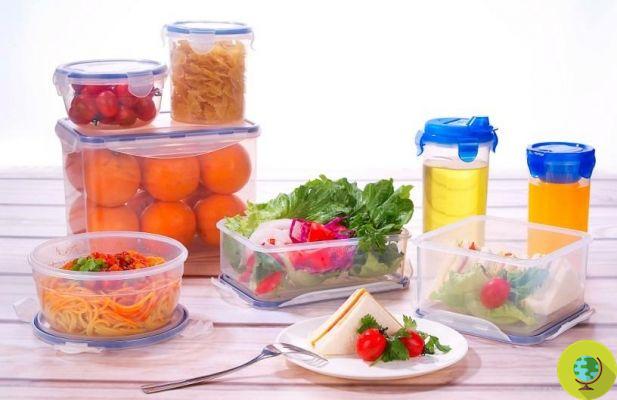
Bisphenol A, while EFSA's assessment of the health risks of BPA is underway, what can we do to protect ourselves and our families? Bisphenol A is unfortunately present in most materials used in the manufacture of food and beverage containers and packaging, including plastic bottles, cans and tin cans for beverages and foods.
Don't store avocado like this: it's dangerous
Bisphenol A, while the evaluation of EFSA on the health risks of the Bpa, how can we do to protect ourselves and our families? Bisphenol A is unfortunately present in most of the materials used for the manufacture of containers and packaging for food and beverages, including plastic bottles, cans and tin cans for drinks and food.
Probable damage to the liver and kidneys, dangers for the development of the fetus and the newborn, as well as for the endocrine system, are just some of the negative consequences that could be linked to the exposure of our organism to Bpa. Now comes a new one from the United States study, which correlates bisphenol A and cancer.
According to US experts, exposure to bisphenol A could cause the appearance of tumors at the level of liver. Further confirmation of the data collected is needed, but the results of the study in question, published in the journal Environmental Health Perspectives, have nevertheless raised the concern of experts. The amount of bisphenol A involved in exposure to this substance could play a fundamental role. Bisphenol A could cause serious damage to our health. Looking forward to further confirmations, how can we start protect ourselves and our family from bisphenol A?
How limit our exposure to BPA? Here are some helpful tips.
Index
Packaged products
According to one study published by Environmental Health Perspectives, it is possible to reduce the level of exposure to Bpa by avoiding as much as possible i packaged foods. Already in just 3 days the first results would be noticed. The 20 participants, from 5 families, followed a diet based on fresh, unwrapped food, free of plastic and tin containers. In just 3 days, the levels of Bpa in urine fell by an average of 66% and those of phthalates by 53-66%. With the return to a diet based on packaged foods, Bpa levels have returned to previous amounts.
Acqua
How to choose the safest water? To avoid contact with the Bpa released from the container to the contents, it would be good to prefer tap water (in the cities where it is drinkable), or buy water in glass bottles. Also use the glass bottles to take water from the municipal fountains.
Plastic bottles
Plastic bottles are not only used for water, but also for other beverages, for example for fruit juices. Try to prefer drinks contained in glass bottles and, if you can, make fruit juices and smoothies at home.
READ also: Is reusing plastic water bottles safe?
Sodas
Carbonated soft drinks may contain traces of bisphenol A from plastic bottles or bottles tin cans. By themselves, fizzy drinks are hardly a cure-all for health. It is possible to avoid them or limit their consumption to rare occasions.
READ also: Fizzy drinks: 10 reasons to stop drinking them
Tin cans
The problem of Bpa that could be contained in cans does not only concern carbonated drinks, but also the packaging of preserved foods, such as tomato puree, corn and canned legumes. Prefer products packaged in bottles and glass jars.
Tetra pak
Buy drinks and packaged foods Tetra pak represents a safe option for those who want to avoid the presence of bisphenol A in packaging. In fact, Tetra Pak containers, despite being partly made of plastic, they do not contain bisphenol A. The percentage of plastic in these packages, equal to about 20%, consists entirely of polyethylene e Polypropylene, which, due to their composition and in agreement with the suppliers of raw materials, do not include this substance among the constituents.
Bottle
To avoid carrying the classic disposable plastic bottles with you to the gym, away from home and while doing sports, it is advisable to opt for a water bottle. But be careful. Water bottles may also contain bisphenol A. So choose one Bpa Free bottle.
Microwave and kitchen
In general it would be good to limit the as much as possible microwave cooking, as there are doubts about the actual safety of this appliance. One of the biggest concerns is the use of plastic containers to reheat food, a process by which they could yield Bpa to food. In the kitchen, avoid plastic containers for storing food as much as possible, replacing them with glass ones. The same goes for plastic cups, plates and cutlery. You can replace the plastic utensils with wooden ones, ladles and cutting boards included. Before buying plastic products, check for a possible Bpa Free label.
READ also: Microwave: 10 reasons to use it as little as possible.
Toys
Try to choose as much as possible safe toys for your children. Be sure of their origin and beware of possible fraud, so that they do not contain toxic substances. Remember that there are alternatives to plastic toys. Let's think about wooden toys, cloth dolls and games that you can create by hand with simple cardboard.
Bulk products
In general, the best advice to limit our body's exposure to Bpa as much as possible concerns the purchase of bulk products or in any case without plastic or tin packaging. To give some examples: fresh fruit and vegetables, dried legumes, pasta and rice and any food as much as possible without packaging that could contain Bpa.
Marta Albè
Photo source: diytrade.com
Read also:
- Bisphenol A: Efsa, the public consultation on safety is underway
- Not only Bisphenol A: the "dirty dozen" of endocrine disruptors
- Plastic in contact with food: why and how to avoid it
- Bisphenol S: the substitute for Bisphenol A is it equally harmful?


























